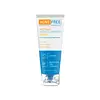What's inside
What's inside
 Key Ingredients
Key Ingredients

 Benefits
Benefits

 Concerns
Concerns

 Ingredients Side-by-side
Ingredients Side-by-side

Water
Skin ConditioningSulfur
AntiseborrhoeicIsoamyl Laurate
EmollientCetyl Ethylhexanoate
EmollientNiacinamide
SmoothingAcacia Senegal Gum
MaskingBentonite
AbsorbentHydroxyethyl Acrylate/Sodium Acryloyldimethyl Taurate Copolymer
Emulsion StabilisingPolyglyceryl-2 Caprate
EmulsifyingOlive Oil Glycereth-8 Esters
EmollientZinc PCA
HumectantAllantoin
Skin ConditioningDipotassium Glycyrrhizate
HumectantMelaleuca Alternifolia Leaf Oil
AntioxidantLeptospermum Scoparium Branch/Leaf Oil
TonicCurcuma Longa Root Extract
MaskingCorallina Officinalis Extract
Skin ConditioningMelia Azadirachta Leaf Extract
Skin ConditioningAmber Powder
Melia Azadirachta Flower Extract
Skin ConditioningCoccinia Indica Fruit Extract
Skin ConditioningSolanum Lycopersicum Leaf Extract
Skin ConditioningOcimum Basilicum Flower/Leaf Extract
TonicQuartz
AbrasivePolysorbate 60
EmulsifyingSorbitan Isostearate
EmulsifyingTocopherol
AntioxidantDisodium EDTA
Phenoxyethanol
PreservativePolysorbate 20
EmulsifyingAlcohol Denat.
AntimicrobialChlorphenesin
AntimicrobialPEG-40 Hydrogenated Castor Oil
EmulsifyingCaprylyl Glycol
EmollientWater, Sulfur, Isoamyl Laurate, Cetyl Ethylhexanoate, Niacinamide, Acacia Senegal Gum, Bentonite, Hydroxyethyl Acrylate/Sodium Acryloyldimethyl Taurate Copolymer, Polyglyceryl-2 Caprate, Olive Oil Glycereth-8 Esters, Zinc PCA, Allantoin, Dipotassium Glycyrrhizate, Melaleuca Alternifolia Leaf Oil, Leptospermum Scoparium Branch/Leaf Oil, Curcuma Longa Root Extract, Corallina Officinalis Extract, Melia Azadirachta Leaf Extract, Amber Powder, Melia Azadirachta Flower Extract, Coccinia Indica Fruit Extract, Solanum Lycopersicum Leaf Extract, Ocimum Basilicum Flower/Leaf Extract, Quartz, Polysorbate 60, Sorbitan Isostearate, Tocopherol, Disodium EDTA, Phenoxyethanol, Polysorbate 20, Alcohol Denat., Chlorphenesin, PEG-40 Hydrogenated Castor Oil, Caprylyl Glycol
Sulfur 3.5%
AntiseborrhoeicWater
Skin ConditioningKaolin
AbrasiveBentonite
AbsorbentGlycerin
HumectantMagnesium Aluminum Silicate
AbsorbentAcacia Senegal Gum
MaskingSodium Bicarbonate
AbrasiveSodium Ascorbyl Phosphate
AntioxidantSodium Cocoyl Isethionate
CleansingPhenoxyethanol
PreservativeXanthan Gum
EmulsifyingCaprylyl Glycol
EmollientTetrasodium EDTA
Ethylhexylglycerin
Skin ConditioningHexylene Glycol
EmulsifyingCoconut Acid
CleansingAvena Sativa Bran Extract
AbrasiveMenthyl Lactate
MaskingZinc PCA
HumectantMagnesium Aspartate
Skin ConditioningZinc Gluconate
Skin ConditioningCopper Gluconate
Skin ConditioningSulfur 3.5%, Water, Kaolin, Bentonite, Glycerin, Magnesium Aluminum Silicate, Acacia Senegal Gum, Sodium Bicarbonate, Sodium Ascorbyl Phosphate, Sodium Cocoyl Isethionate, Phenoxyethanol, Xanthan Gum, Caprylyl Glycol, Tetrasodium EDTA, Ethylhexylglycerin, Hexylene Glycol, Coconut Acid, Avena Sativa Bran Extract, Menthyl Lactate, Zinc PCA, Magnesium Aspartate, Zinc Gluconate, Copper Gluconate
 Reviews
Reviews

Ingredients Explained
These ingredients are found in both products.
Ingredients higher up in an ingredient list are typically present in a larger amount.
Acacia Senegal Gum has skin soothing, thickening, and formulation stabilizing properties. It comes from the Acacia tree that is native to sub-Saharan Africa.
Bentonite is an aluminium phyllosilicate clay with great absorbent properties. The name 'bentonite' comes from the area where the largest source is found: Fort Benton, Wyoming.
As a clay, bentonite is often used to absorb excess oil and provide exfoliation. It has also been shown to have some antibacterial and anti-inflammatory properties. Studies show bentonite was effective at calming dermatitis from poison ivy and in diaper dermatitis of infants. Bentonite has also been shown to act as a barrier against toxic compounds on your skin.
Sunscreens containing bentonite display higher water resistance and stay on the skin for much longer. The sunscreens containing bentonite also show higher potency and UV light absorbtion.
Bentonite is naturally created from volcanic ash and several natural weathering/hydrothermal processes.
A common usage of bentonite is removing excess protein from white wines. Bentonite contains a property of being able to absorb large amounts of protein from aqueous solutions.
Phyllosilicate clay has a structure formed by sheets.
Learn more about BentoniteCaprylyl Glycol is a humectant and emollient, meaning it attracts and preserves moisture.
It is a common ingredient in many products, especially those designed to hydrate skin. The primary benefits are retaining moisture, skin softening, and promoting a healthy skin barrier.
Though Caprylyl Glycol is an alcohol derived from fatty acids, it is not the kind that can dry out skin.
This ingredient is also used as a preservative to extend the life of products. It has slight antimicrobial properties.
Learn more about Caprylyl GlycolPhenoxyethanol is a preservative that has germicide, antimicrobial, and aromatic properties. Studies show that phenoxyethanol can prevent microbial growth. By itself, it has a scent that is similar to that of a rose.
It's often used in formulations along with Caprylyl Glycol to preserve the shelf life of products.
Sulfur is a commonly occurring element on Earth (and our universe!). In cosmetics, it helps kill bacteria, reduces sebum, and provides exfoliation. This makes it an effective ingredient to reduce breakouts and fight acne.
As a ketayolytic agent, it breaks down the top layer of skin. This is a form of exfoliation and may help decrease acne and hyperpigmentation.
Studies show sulfur has antibacterial and antifungal properties. Sulfur can be drying if used excessively or at higher concentrations. We recommend speaking with a medical professional if you have any concerns.
Ancient Greece, India, China, and Egypt have used sulfur in both traditional medicines and for household use.
Learn more about SulfurWater. It's the most common cosmetic ingredient of all. You'll usually see it at the top of ingredient lists, meaning that it makes up the largest part of the product.
So why is it so popular? Water most often acts as a solvent - this means that it helps dissolve other ingredients into the formulation.
You'll also recognize water as that liquid we all need to stay alive. If you see this, drink a glass of water. Stay hydrated!
Learn more about WaterZinc PCA (or "zinc salt") differs slightly from zinc itself. PCA stands for pyrrolidone carboxylic acid. However, Zinc PCA comes from zinc.
It can help reduce redness, regulate sebum, and promote the general healing process of the skin.
Zinc PCA tends to be especially useful for those with oily, acne-prone skin. It's certainly an ingredient worth trying out!
Learn more about Zinc PCA